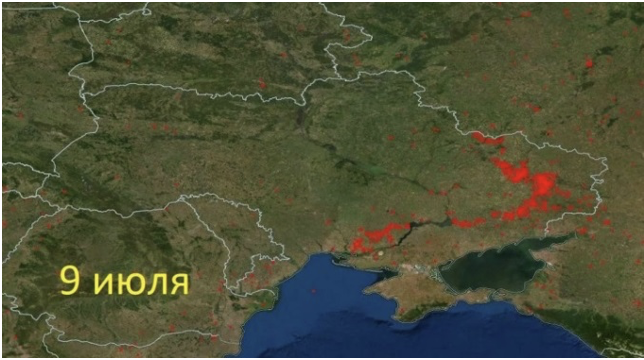‘The situation on the front line during the special military operation of the Russian Armed Forces in Ukraine is largely determined by the nature of the work of the artillery of the parties to the conflict.’
So sentenced Alexander Khodakovsky, Commander of the Donetk People’s Republic Vostok Brigade and one of the war’s prominent milbloggers. At the height of the summer fighting in 2022 he seemed right. The Russian Army appeared remorseless and unstoppable. As many as 60,000 shells were being fired off every day. The intensity of fire was so heavy it was being recorded by NASA FIRMS1 satellites.

By August, 2022 an estimated 7 million shells had been expended (for comparison, in the first eight days of the Somme the British Army expended 1.73 million shells). In the colourful language of former British Prime Minister , Boris Johnson, the Russian Army was chewing up the ground.
Those days have passed and a chastened and diminished Russian Army is now mired in grim trench warfare. This article examines the fall from grace of the Russian God of War – the Rocket and Artillery Troops.
‘Shell hunger’
The extravagant use of ammunition in the first half of the war has provoked the phenomenon of ‘shell hunger’, also experienced by the Ukrainian Armed Forces but for different reasons. More widely, under-estimation of shell demand in general war has been universal and one of the lessons of the war (or a revisited lesson in the case of a country like Britain that experienced the ‘shell crisis’ of 1915 and fall of the Asquith government).
Two principal factors have contributed to shell hunger in Russia. The first is production capacity. There is no certain data on Russian defence industry but a comparison can be made with the United States. Pre-war, US defence industry was producing 14,000 155mm shells per month, or as many as the Ukrainian Army expends in two days. Production has been ramped up, but as NATO Secretary General Stoltenberg recently remarked, if an order were placed now, the first batch of shells would arrive in two-and-a-half years’ time.
The second factor is a shortage of Thiokol. Thiokol is an essential sealant used in artillery shells, rockets or other products that experience high temperatures and pressures. Russia went to war with a single plant capable of manufacturing this compound (KZSK-Silicon JSC), insolvent and owing over 3 billion roubles, and subject to a court ruling by the Arbitration Court of the Republic of Tatarstan.
Russia has limited options for suppliers. Notwithstanding Moscow’s denials, North Korea has begun covertly shipping a ‘significant number’ of artillery shells to Russia. Belarus has transferred over 65,000 tons of ammunition to Russia (on 1,940 rail flatcars to give a sense of scale). A Pentagon official has briefed Russia is using 40-year old ammunition from reserve stocks. Ukrainian defenders have noticed the increase in dud shells. Russian gunners have admitted, ‘Sometimes shells come from ‘very long storage’, in which, due to problematic threads, it is difficult to install a fuse.’
An inevitable consequence has been reduced weights of fire by as much as 75%, with a daily maximum of around 20,000 shells. Although the volume of fire has fallen significantly, the number of targeted locations has not. Every day, the Russian Army shells around 100 settlements. The majority have been shelled for months and are now uninhabited wastelands.

‘Shell hunger’ has generated competition for shells. Most recently, a group of Wagner gunners posted a YouTube video complaining of a lack of ammunition resupply from MOD. Tensions between Wagner boss Yevgeny Prighozin and the MOD have been boiling over for months. As the MOD controls supply to the front, this is one way it can take revenge on one of its most vocal critics.
Headlines created by ‘shell hunger’ have eclipsed another problem: charge bags. In the words of a Russian gunner: ‘We really had problems, only not with shells, but with charges. Moreover, with distant ones. We could not shoot at full range, we had to drive as close as possible to the positions and try to reach the targets.’
Equipment Losses
The Russian Army has suffered catastrophic vehicle losses after one year of war (over 9,250 destroyed, damaged, captured or abandoned). At the time of writing, at least 231 C2 (command and control) platforms have been lost, highlighting the vulnerability of HQs and associated communications nodes. These losses also offer explanation why the Russian operational level has long collapsed and why Moscow’s war has degenerated into scores of company and platoon-level operations.
The relatively low number of artillery C2 losses reflects the obsolescence of the IV-series vehicles. Pre-war, TV Zvezda2, every week, broadcast shorts (2-3 minute clips) on gunnery and rocket training. The format was unvarying. IV-series vehicles never appeared in these clips. Commanders (the officers) were invariably filmed in WW2-style bunkers, with guns lined up on pre-surveyed firing points as if on a parade ground. For years, Russia’s Rocket and Artillery Troops had been self-deluding over their ability to conduct dynamic C2.
Gun and rocket system losses have also been disastrous. A Russian battery comprises six guns or rocket systems. Three batteries make a battalion-sized unit confusingly known as a ‘division’ but titled a ‘regiment’ (18 guns or rocket systems). And two ‘divisions’ or ‘regiments’ make up an artillery brigade. In total, the Russian Army has lost almost 40 regiments of guns and rocket systems. This is more than any NATO army fields, with the exception of the US armed forces.

Equipment degradation
Testimony from Russian gunners offers of a portrait of a degraded force labouring with inoperative equipment. A loader serving in a 152mm 2S3(M) Akatsiya battery has reported, ‘the loading mechanism did not work on any of the installations [and] the general deterioration of the barrels and mechanisms led to constant shot failures.’ He also reported the purge and ventilation systems were inoperative so after firing a dozen shells the crew compartment filled with toxic smoke. The heating systems had broken down leading to freezing compartments in recent weeks. Whenever he complained he received the same answer: ‘it cannot be repaired.’
Communications were ‘ancient’ and ‘lousy’ with a 10-12 kilometre range. ‘At least, we were given corrections from the command post by radio,’ he added. As for accuracy of fire, ‘it left much to be desired.’
Changes of tactics
At the beginning of the war, Russian Rocket and Artillery Troops were criticised for conducting out-dated ‘Soviet’ tactics and procedures. These were contrasted unfavourably with agile Ukrainian ‘Western-style’ tactics. The reality is both sides have adapted as the war has lengthened.
The principal change on the Russian side has been the adoption of ‘shoot and scoot’ tactics illustrated in the schematic below. The tactic, if not the exact procedures followed by Russian artillery, will be familiar to gunners in NATO armies.

A second tactic is the ‘nomadic battery’.3 The Russians have been shelling the same settlements every day for months. To avoid pattern-setting and counter-battery fire, multiple firing points are surveyed. Guns travel between the firing points and employ ‘shoot and scoot’. The firing points are selected away from own positions to avoid attracting return fire.
A third tactic is the ambush. A fire mission is conducted to deliberately provoke counter-battery fire. The firing position is detected and plotted by counter-battery radar, EW or uncommonly by sound-ranging.4 According to gunners serving in 150th Motor Rifle Division, ‘this was made possible by equipping artillery units with their own reconnaissance equipment (radar, sound and optical), acquired mainly with the money of military personnel or through the efforts of volunteers.’ Quadcopter drones are also bought by organising collections in garrison towns and home territories. Lancet kamikaze drones, long-range guns or attack aviation are then used to attack the firing point. Speed, obviously, is the key as Ukrainian guns are practised at dispersal and concealment.

Changes in tactics have been enabled by changes in communications and procedures. Useless legacy Soviet-era tactical radios have been replaced by local networks based on Motorola radios. These, like the quadcopters and other kit, are commonly funded by organising collections. Before, calls for fire could take from 30 minutes to 4 hours because the Russian Army command system implied a whole chain of approvals with the fire decision made by a senior commander. An unintended benefit of the breakdown of Russian tactical C2 systems has thus been greater autonomy at battery level.
While these (forced) changes demonstrate the capacity to learn lessons and adapt, they continue to be eclipsed by the salient point about Russian gunnery: the bankruptcy of fire without manoeuvre. The Russian Army’s inability to coordinate combined arms operations successfully – or today at all – at battalion-level and above has resulted in 100s of kilometres of positional, attrition warfare. ‘When we entered the forest strips,’ a fighter on the Ukrainian side has observed laconically, ’we saw that the ground there was literally mixed with corpses and tree fragments...and you can’t tell which of these dead are Russians and which are Ukrainians.’ The grotesque spectacle of WWI landscapes is being revisited. ‘Meat attacks’ have become the modern Russian Army’s contribution to military art.

Perhaps this is the over-arching lesson of the war: manoeuvre – or you will revisit the First World War.
Sergio Miller
Sergio Miller is a retired British Army Intelligence Corps officer. He was a regular contributor and book reviewer forBritish Army Review. He is the author of a two-part history of the Vietnam War (Osprey/Bloomsbury) and is currently drafting a history of the Russian invasion of Ukraine.
Footnotes
- Fire Information for Resource Management System
- The Russian MOD channel
- In the case of mortars, the term ‘roaming mortars’ is used.
- The August 2022 edition of the Russian MOD journal Armeiskii Sbornik includes an article of this subject




